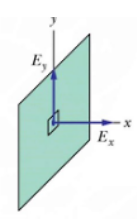
An infinite large plate has a net positive charge. When referring to the electric field just as it is coming out of the plate:
A. Some of the electric field is perpendicular to the plate
B. All of the electric field is perpendicular to the plate
C. None of the electric field is perpendicular to the plate
D. There is no electric field coming out of the plate
Answer
505.2k+ views
Hint: The electric force per unit charge is known as the electric field. The force that the field will apply on a positive test charge is assumed to be in the same direction as the field's direction. A positive charge's electric field is radially outward, and a negative charge's field is radially inward.
Complete answer:
Gauss's law, also known as Gauss's flux theorem (or simply Gauss's theorem) in physics, is a law that governs the propagation of electric charge and the resulting electric field. It states that the flux of the electric field out of every closed surface is equal to the electric charge enclosed by the surface, regardless of how that charge is transmitted, in its integral form.
Even if the rule by itself is insufficient to evaluate the electric field over a surface enclosing some charge distribution, in situations where symmetry requires uniformity of the field, this could be possible. The cumulative flux associated with a closed surface is \[\dfrac{1}{{{\varepsilon _o}}}\] times the charge enclosed by the closed surface, according to the Gauss theorem.
According to Gauss's theorem, all electric field lines originating from an infinitely charged plate are perpendicular to the plate.Magnitude of electric field \[{\rm{E}} = \dfrac{\sigma }{{2{_{\rm{o}}}}}\].

Hence option B is correct.
Note: The sources (positive charges) and sinks (negative charges) of electric fields sealed by the surface are the only sources (positive charges) and sinks (negative charges) of electric flux from any closed surface. The electric flux is unaffected by any charges outside the floor. Furthermore, only electric charges can serve as electric field sources or sinks.Changing magnetic fields, for example, cannot function as electric field sources or sinks.
Complete answer:
Gauss's law, also known as Gauss's flux theorem (or simply Gauss's theorem) in physics, is a law that governs the propagation of electric charge and the resulting electric field. It states that the flux of the electric field out of every closed surface is equal to the electric charge enclosed by the surface, regardless of how that charge is transmitted, in its integral form.
Even if the rule by itself is insufficient to evaluate the electric field over a surface enclosing some charge distribution, in situations where symmetry requires uniformity of the field, this could be possible. The cumulative flux associated with a closed surface is \[\dfrac{1}{{{\varepsilon _o}}}\] times the charge enclosed by the closed surface, according to the Gauss theorem.
According to Gauss's theorem, all electric field lines originating from an infinitely charged plate are perpendicular to the plate.Magnitude of electric field \[{\rm{E}} = \dfrac{\sigma }{{2{_{\rm{o}}}}}\].

Hence option B is correct.
Note: The sources (positive charges) and sinks (negative charges) of electric fields sealed by the surface are the only sources (positive charges) and sinks (negative charges) of electric flux from any closed surface. The electric flux is unaffected by any charges outside the floor. Furthermore, only electric charges can serve as electric field sources or sinks.Changing magnetic fields, for example, cannot function as electric field sources or sinks.
Recently Updated Pages
A man running at a speed 5 ms is viewed in the side class 12 physics CBSE

The number of solutions in x in 02pi for which sqrt class 12 maths CBSE

State and explain Hardy Weinbergs Principle class 12 biology CBSE

Write any two methods of preparation of phenol Give class 12 chemistry CBSE

Which of the following statements is wrong a Amnion class 12 biology CBSE

Differentiate between action potential and resting class 12 biology CBSE

Trending doubts
What are the major means of transport Explain each class 12 social science CBSE

Which are the Top 10 Largest Countries of the World?

Draw a labelled sketch of the human eye class 12 physics CBSE

Explain sex determination in humans with line diag class 12 biology CBSE

Explain sex determination in humans with the help of class 12 biology CBSE

Differentiate between homogeneous and heterogeneous class 12 chemistry CBSE




